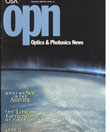
November 1999 Issue
Feature Articles
What We See in the Aurora
The aurora is a particularly spectacular optical phenomenon because of its great variety: the aurora's color, shape, and motion change, sometimes slowly, sometimes rapidly, before the viewer's eye. On some long, quiet Arctic nights, the aurora takes the form of a dim green glow on the horizon; on other nights, the colors of the aurora swirl and dance overhead like a grand ballet. Even people who have lived long under the aurora's splendor pause on such nights to stare skyward.
by Joseph A. ShawThe Lost Generation of Fiber Optics
Some engines start the first time; others require several tries. The same thing can happen when new technologies are launched. Fiber-optic imaging was first "invented" in the late 1920s, but a generation was "lost" before the technology was reinvented in the 1950s. Imaging bundles were invented by different people at least five times during the course of those thirty years. The history of fiber optics is a sobering reminder to inventors and scientists alike that a bright idea alone may not be sufficient.
by Jeff HechtThe Faraday Effect
In this issue of Optics & Photonics News, the Engineering column has been expanded to highlight one of the major technical achievements of Michael Faraday, a founding father of the field of electromagnetics.
by Masud MansuripurUltra Wide-Angle Eyepiece for a virtual Reality Display
Virtual reality displays typically consist of two image sources with suitable collimating optics (eyepieces) all packaged in a head mount. To keep the package as small as possible, it is necessary to keep the collimating optics very compact while maintaining adequate image quality. The optics should also cover as wide a field as possible to help create a sense of total immersion in the virtual environment. Yet another requirement is to keep the pupil size as large as possible to accommodate eye rotation and reduce mounting tolerances.
by J. Brian Caldwell

![A multiplexed image of a human tonsil acquired. [NIAID] using the iterative bleaching extends multiplexity (IBEX) method.](https://opnmedia.blob.core.windows.net/$web/opn/media/images/articles/2024/0424/departments/202404-cover-web.jpg?ext=.jpg)
